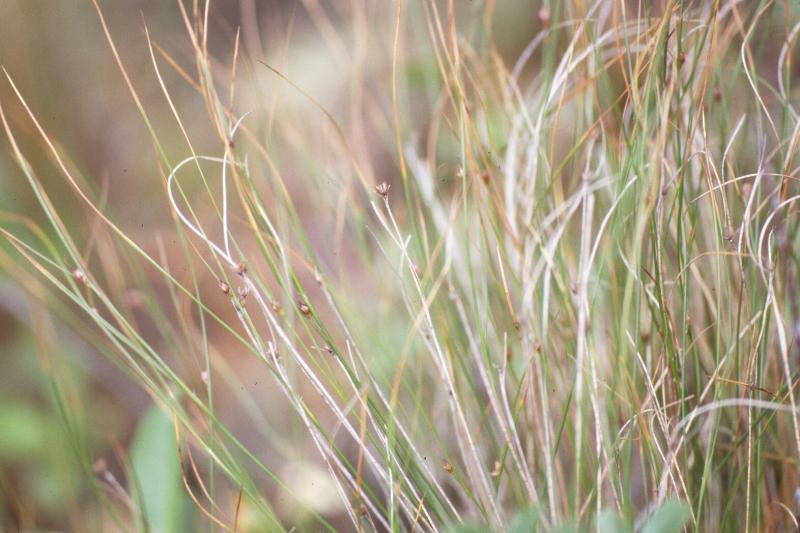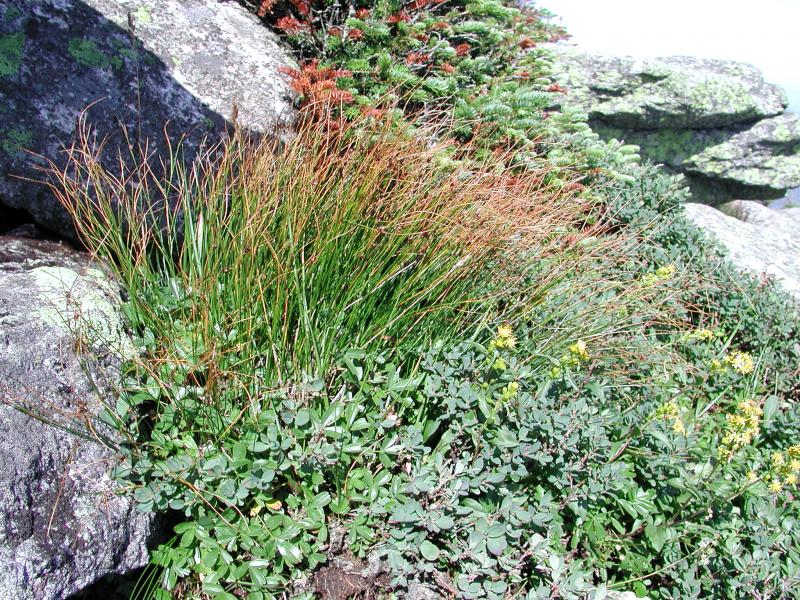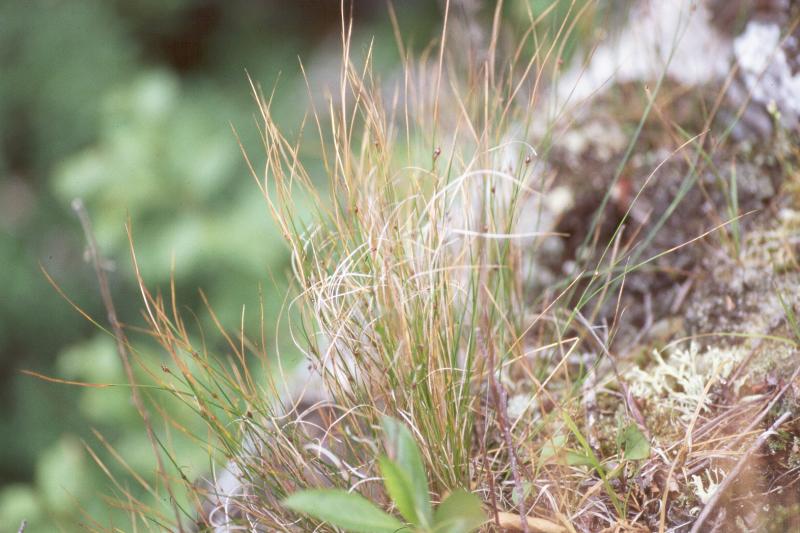Highland Rush
Oreojuncus trifidus (Linnaeus) Záveská Drábková & Kirschner
- Class
- Monocotyledoneae (Monocots)
- Family
- Juncaceae (Rush Family)
- State Protection
- Threatened
Listed as Threatened by New York State: likely to become Endangered in the foreseeable future. For animals, taking, importation, transportation, or possession is prohibited, except under license or permit. For plants, removal or damage without the consent of the landowner is prohibited.
- Federal Protection
- Not Listed
- State Conservation Status Rank
- S2
Imperiled in New York - Very vulnerable to disappearing from New York due to rarity or other factors; typically 6 to 20 populations or locations in New York, very few individuals, very restricted range, few remaining acres (or miles of stream), and/or steep declines.
- Global Conservation Status Rank
- G5
Secure globally - Common in the world; widespread and abundant (but may be rare in some parts of its range).
Summary
Did you know?
This is the dominant Juncus species found in the alpine habitat of the Adirondacks. The species name trifidus means three-forked, and is probably in reference to the often three parted ear-like appendages at the base of the leaf blades, or perhaps to the character of the three upper leaves, often being just below the flowers. These two features make this rush easy to identify in the field.
State Ranking Justification
There are ten known extant populations. Eight are from the Adirondacks and two are from the Shawangunks. Four populations are very small, with fewer than 50 plants each. There are also three or four historical populations which have not been seen in over 20 years. One of these populations has probably become extirpated. Survey work is needed to determine whether the other historical populations have become extirpated as well.
Short-term Trends
Five of the ten known extant populations were first discovered within the past 25 years. It is likely that these are not new populations but rather were overlooked in the past. Four populations have fewer than 50 plants, but clear short-term trends at these and other populations are unknown.
Long-term Trends
There are three or four populations that have not been seen in over 20 years but survey work is needed to determine if they have become extirpated. Five of the ten known extant populations were first discovered within the past 25 years. It is likely that these are not new populations but rather were overlooked in the past. Overall, long-term trends are unclear.
Conservation and Management
Threats
A few populations are threatened, at least in part, because of trampling by hiker traffic. One population occurs on cliffs in a crevice where a trail goes through. These plants are subject to picking by hikers.
Conservation Strategies and Management Practices
The Summit Steward program, which works to inform hikers of the fragile nature of alpine plants, is a critical program which is helping to reduce trampling of alpine vegetation. This program and other efforts designed to reduce trampling of alpine meadows are needed.
Research Needs
The three or four populations only known from historical records need to be inventoried. A few known extant sites need to be surveyed to better assess their current condition.
Habitat
Habitat
In New York, Juncus trifidus occurs in two main areas: the high peaks of the Adirondacks and the Shawangunk Ridge in the southeastern part of the state. In the Adirondacks it occurs in the alpine regions of some of the highest mountains, and on slightly lower exposed cliffs and ledges. The plants grow in open alpine meadows, rock outcrops, cliffs, and ledges, often in thin soil over granitic or anorthosite bedrock. In the Shawangunks, this species grows on vertical cliffs and ledges of conglomerate bedrock, and at one location from a sandy lake shore (New York Natural Heritage Program 2007). Mostly in crevices of granitic (schistose) cliffs or rubble slopes in the higher regions of the Appalachians (Brooks and Clemants 2000). Rock crevices and alpine meadows (Gleason and Cronquist 1991). Dry, granitic conglomerate or quartzite ledges in New York; elsewhere also occurring on dry barrens and sands (Clemants 1990). Arctic region south to acid or sterile rocky or sandy barrens and mountains of Newfoundland and bare mountains of Quebec, northern New England, and northern New York. Dry cliffs and crests of central New Hampshire to eastern New York and south to the mountains of North Carolina (Fernald 1970).
Associated Ecological Communities
- Cliff community
(guide)
A community that occurs on vertical exposures of resistant, non-calcareous bedrock (such as quartzite, sandstone, or schist) or consolidated material; these cliffs often include ledges and small areas of talus.
- Open alpine community
(guide)
An open community consisting of a mosaic of sedge/dwarf shrub meadows, dwarf heath shrublands, small boggy depressions, and exposed bedrock covered with lichens and mosses. The open alpine community occurs above timberline (about 4,900 ft or 1,620 m) on the higher mountain summits and exposed ledges of the Adirondacks. The flora includes arctic-alpine species that are restricted (in New York) to these areas, as well as boreal species that occur in forests and bogs at lower elevations. The soils are thin and organic, primarily composed of peat derived from peat mosses (Sphagnum spp.) or black muck. The soils are often saturated because they can be recharged by atmospheric moisture.
Associated Species
- Amelanchier arborea (downy shadbush)
- Betula cordifolia (mountain paper birch)
- Carex bigelowii
- Kalmia latifolia (mountain laurel)
- Pinus rigida (pitch pine)
- Salix uva-ursi (bearberry willow)
- Sibbaldiopsis tridentata
Range
New York State Distribution
In New York, Juncus trifidus is restricted to the high peaks region of the Adirondacks and the Shawangunks in the southeastern part of the state.
Global Distribution
This species occurs in Europe, Asia, and North America. In North America it grows from Greenland and northern Quebec south to the high mountains of northern New England and the Adirondacks, disjunct in the Shawangunks in southeastern New York, and disjunct to the highest mountains of the southeastern United States (West Virginia, Virginia, and North Carolina) (Brooks and Clemants 2000, Weakley 2006).
Identification Comments
General Description
Arctic rush is a tufted grass-like perennial. It is mostly composed of fine rounded stems 10-40 cm tall. At the base of the stems are a few inconspicuous scale-like structures. A few leaves also occur on the stems, often just below the flowers. The leaves have tiny teeth, and their blades are up to 6 cm long. There are between 1-3 small flowers at the top of the stem. As with all rushes, each flower has 6 small petal-like structures (tepals). The flowers develop into capsules 2.2-3.5 mm long, which at maturity open to reveal brown seeds 0.9-1.3 mm long (Brooks and Clemants 2000).
Identifying Characteristics
Best Life Stage for Proper Identification
This species is easiest to identify when it is in flower or fruit.
Similar Species
Arctic Rush can be separated from other Juncus species by its combination of serrulate leaf blades, having the upper 1-4 leaves often just below the inflorescences, and having only 1-3(-4) flowered inflorescences.
Best Time to See
Juncus trifidus starts to flower and fruit in June and fruits may persist through September.
- Fruiting
The time of year you would expect to find Highland Rush fruiting in New York.
Highland Rush Images
Taxonomy
Highland Rush
Oreojuncus trifidus (Linnaeus) Záveská Drábková & Kirschner
- Kingdom Plantae
- Phylum Anthophyta
- Class Monocotyledoneae
(Monocots)
- Order Juncales
- Family Juncaceae (Rush Family)
- Order Juncales
- Class Monocotyledoneae
(Monocots)
- Phylum Anthophyta
Additional Common Names
- Arctic Rush
Synonyms
- Juncus monanthos Jacq.
- Juncus trifidus L.
- Juncus trifidus ssp. carolinianus Hamet-Ahti
- Juncus trifidus ssp. monanthos (Jacq.) Asch. & Graebn.
- Juncus trifidus var. monanthos (Jacq.) Bluff & Fingerhuth
Comments on the Classification
Work by Drábková (2003) shows that Juncus trifidus is more closely related (and sister) to Luzula than Juncus. More work is needed to confirm the placement of J. trifidus. Hämet-Ahti (1980) considers some North American plants, as J. trifidus ssp. carolinianus, distinct from European and Asia plants. Clemants (1990) disagrees with her assessment and places ssp. carolinianus in synonymy. The taxon J. monanthos (which is sometimes recognized as a variety or subspecies of J. trifidus) has been misapplied to North American plants. If recognized, it is strictly an old world taxon. Brooks and Clemants (2000) place it in synonymy of J. trifidus.
Additional Resources
Best Identification Reference
New York Natural Heritage Program. 2010. Biotics database. New York Natural Heritage Program. New York State Department of Environmental Conservation. Albany, NY.
Other References
Brooks, R.E. and S.E. Clemants. 2000. Juncaceae Jussieu. Pages 211-267 in Flora of North America Editorial Committee (Editors), Flora of North America, north of Mexico, Volume 22, Magnoliophyta: Alismatidae, Arecidae, Commelinidae (in part), and Zingiberidae. Oxford University Press, New York, NY, USA. 352pp + xxiii.
Clemants, Steven E. 1990. Juncaceae (rush family) of New York State. Contributions to a flora of New York State VII Richard S. Mitchell, ed. New York State Museum Bulletin No. 475. 67 pp.
Drábková, L., J. Kirschner, O. Seberg, G. Petersen, and ?. Vl?ek. 2003. Phylogeny of the Juncaceae based on rbcL sequences, with special emphasis on Luzula DC. and Juncus L. Plant Systematics and Evolution 240: 133-147.
Fernald, M.L. 1950. Gray's manual of botany. 8th edition. D. Van Nostrand, New York. 1632 pp.
Gleason, Henry A. and A. Cronquist. 1991. Manual of Vascular Plants of Northeastern United States and Adjacent Canada. The New York Botanical Garden, Bronx, New York. 910 pp.
Holmgren, Noel. 1998. The Illustrated Companion to Gleason and Cronquist's Manual. Illustrations of the Vascular Plants of Northeastern United States and Adjacent Canada. The New York Botanical Garden, Bronx, New York.
Hämet-Ahti, L. 1980. Juncus trifidus L. subsp. carolinianus Hämet-Ahti, n. subsp., in eastern North America. Veröff. Geobot. Inst. ETH Stiftung Rübel, Zurich 69: 7-13.
Mitchell, Richard S. and Gordon C. Tucker. 1997. Revised Checklist of New York State Plants. Contributions to a Flora of New York State. Checklist IV. Bulletin No. 490. New York State Museum. Albany, NY. 400 pp.
New York Natural Heritage Program. 2024. New York Natural Heritage Program Databases. Albany, NY.
Reschke, Carol. 1990. Ecological communities of New York State. New York Natural Heritage Program, New York State Department of Environmental Conservation. Latham, NY. 96 pp. plus xi.
Weldy, T. and D. Werier. 2010. New York flora atlas. [S.M. Landry, K.N. Campbell, and L.D. Mabe (original application development), Florida Center for Community Design and Research http://www.fccdr.usf.edu/. University of South Florida http://www.usf.edu/]. New York Flora Association http://newyork.plantatlas.usf.edu/, Albany, New York
Záveská Drábková L. and J. Kirschner. 2013. Oreojuncus, a new genus in the Juncaceae. Preslia 85: 483-503.
Links
About This Guide
Information for this guide was last updated on: December 11, 2008
Please cite this page as:
New York Natural Heritage Program. 2024.
Online Conservation Guide for
Oreojuncus trifidus.
Available from: https://guides.nynhp.org/arctic-rush/.
Accessed July 26, 2024.


